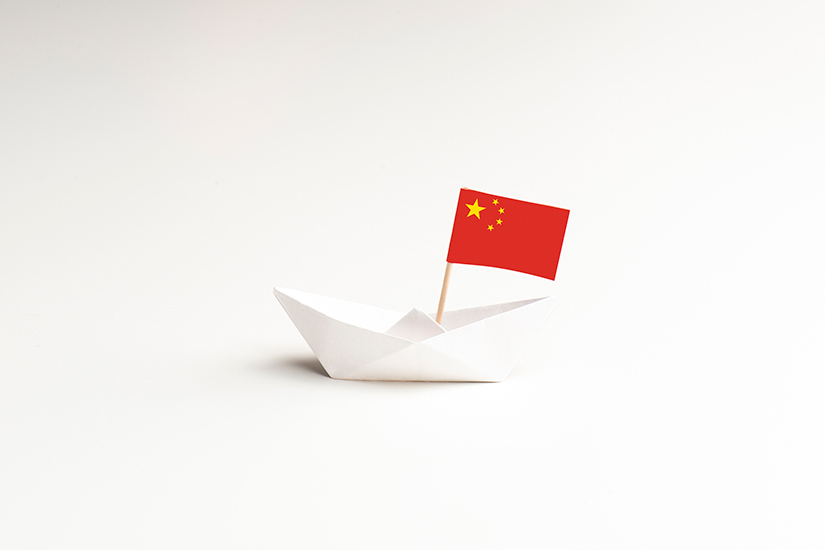Introduction
Among the vessels participating in Exercise Maritime Cooperation, the April 2023 joint drill between the Chinese and Singaporean militaries off the coast of Singapore, were the People’s Liberation Army Navy (PLAN)’s mine-hunting ship (MHS) Chibi and guided-missile frigate Yulin.[1] Maritime security experts generally saw the joint exercise, conducted since 2021, as promoting mutual understanding and friendship between the two countries’ navies. But specialists in mine warfare were startled by the inclusion of the PLAN’s mine countermeasures (MCM) vessel, which requires advanced features to be deployed abroad. The dispatch of such a ship to Singapore suggested that China had succeeded in significantly upgrading its MCM capabilities.
In the following, I examine whether such capabilities have truly exceeded those of the United States and Japan—widely regarded as possessing strong mine warfare expertise.[2] This is a factor of great significance, given the high probability of mine warfare in a Taiwan contingency. I will analyze the extent to which China’s MCM capabilities have improved by reviewing the number of relevant vessels, their equipment, and the skills of their crew.

1. Participation of MCM Vessels in Overseas Exercises
Due to the nature of mines, MCM vessels operate in relatively shallow coastal waters.[3] Japan sent minesweeper coastal (MSC) ships to the Persian Gulf in 1991 following the Gulf War, and the successful completion of their mission reaffirmed the high level of Japan’s MCM capabilities. It also demonstrated the ability of these vessels to overcome tremendous challenges in navigating the open seas[4] —a significant achievement considering that the Russian Navy, operating with a reduced budget since the end of the Cold War, was unable to send its MCM vessels abroad from its home port in Vladivostok due to poor maintenance and skill levels of their crew.[5]
And while the international RIMPAC maritime exercise held biennially includes MCM training, it alone is conducted around the port of San Diego—rather than in Hawaii—due to the risks posed by ocean travel. Unlike cruisers and frigates, MCM vessels must have high ocean-going and anti-mine capabilities to participate in overseas exercises with other militaries.[6] This requires a crew with high navigation and MCM skills, a seaworthy hull, and effective MCM equipment. Also needed are satellite and other capabilities to gather weather and maritime information, the ability to collect and communicate security information, and overseas logistics capabilities.
The participation of the PLAN’s Chibi in the Singapore exercise signifies that it is equipped with such operational capabilities.
2. Comparison of Japanese, US, and Chinese MCM Hardware
The table below shows the number of MCM vessels held by China’s PLAN, Japan’s Maritime Self-Defense Force, and the US Navy as of August 2023.
| Type/Country | China | Japan | United States |
|---|---|---|---|
| MCM vessels | 40 + | 21 | 8 (−8 in 2024) |
| Can control USVs | Included in above | 4 + 18 (see note 7) | 9 + 4 (see note 7) |
| USVs | 15 + | + (see note 7) | 4 |
| Total | 55 + | 25 + 18 | 17 − 4
13 (from 2024) |
| Ship type | Type 081A
Type 082 I and II
Type 529 |
Sugashima class
Hatsushima class
Awaji class
FFM Mogami class |
Avenger class
Freedom class
USV (excl. Independence class) |
Table 1. MCM and Related Vessels Owned by Japan, the United States, and China[7]
As Table 1 shows, China already has more MCM vessels than either Japan or the United States. China began commissioning domestically produced MCM vessels in 1962 following the Korean War, but their capabilities were largely lost during the Cultural Revolution (1966–76).[8] The need to build up anti-mine capabilities after the Vietnam War led to the commissioning of Type 082 harbor minesweeper in 1987.[9] New developments were halted due to defense budget cuts during the period of reform and opening up, though, and the Wochi-class Type 081 and Wozang-class Type 082 I/II vessels were not commissioned until 2005.[10] The PLAN has since been modernizing its fleet by decommissioning older ships and building new-generation vessels.[11] More than 15 unmanned surface vessels (USVs) are already in service, greatly surpassing in quantity and quality those held by Japan and the United States.
Japan, meanwhile, is commissioning new MCM vessels with improved capabilities. The dispatch of minesweepers to the Persian Gulf in 1991 led to the realization that Japanese equipment on these vessels was quite out of date, so the 12 Sugashima-class vessels that entered service beginning in 1999 were equipped with the same information processing, mine detection, and mine neutralization equipment as those installed on British Sandown-class minehunters.[12] In 2015, six new vessels were commissioned, including Hirashima-class vessels with equivalent, domestically produced systems and Enoshima-class vessels with upgraded mine detection capabilities. They carry the world’s only underwater vehicles combining mine neutralization equipment with a self-propelled variable depth sonar. This was followed in 2017 with the latest generation Awaji-class minesweepers capable of conducting mine warfare in the open sea[13] and Mogami-class (FFM) multi-mission frigates with MCM capabilities in 2022. There are plans to build 22 FFMs in the future, to be equipped with unmanned underwater vehicles (UUVs) and USVs (currently undergoing testing).
The United States, on the other hand, is expected to decommission all Avenger-class specialized MCM vessels in 2024. They are being replaced by two types of littoral combat ships (LCSs) that will use UUVs and USVs to perform MCM operations. The monohull Freedom-class LCS can accommodate MCM mission packages but is plagued by various operation issues,[14] while the trimaran hull Independence-class LCS is currently undergoing testing for USV operations, for which it is suited.
3. Comparison of Japanese, US, and Chinese MCM Experience and Expertise
There is more to MCM capabilities than just equipment; also important are non-hardware components like experience and expertise. As for experience, Japan’s MCM units worked to clear approximately 55,000 mines laid by the Imperial Japanese Navy as defensive minefields around Japan during World War II, as well as around 6,500 remaining mines of the approximately 10,000 placed by the US Navy to disrupt wartime maritime traffic. These efforts resulted in 78 people being killed in the line of duty, but by 1952 enough mines had been disposed of to make major shipping lanes safe for navigation (although clearing operations continued through 1985), laying the foundation for Japan’s revival as a maritime nation.[15] Upon the orders of the US-led Allied occupation forces, Japan also cleared 27 Russia-supplied mines laid by North Korea during the Korean War that began in 1950.[16]And in 1991, following the Gulf War, a Japanese minesweeping unit traveled some 7,000 nautical miles (13,000 km) to the Persian Gulf to engage in MCM operations to clear 34 mines laid by Iraq.[17] This was Japan’s biggest contribution to the US-led coalition war effort. Japan’s MCM units have thus accumulated broad experience in actual warfare.
US units were also involved, albeit on a smaller scale, in clearing mines around Japan after World War II. They also operated during the Korean War and played a leading role clearing mines in the Persian Gulf after the Gulf War.[18] China sought to clear mines laid by US warplanes during the Vietnam War in 1972–73 and disposed of 46 mines with at least one casualty,[19] but it has not engaged in wartime mine-clearing operations since then.
Building on its experience described above, Japan has continued to conduct training on mine countermeasures and mine disposal and undertakes joint training with US forces.
US MCM units are headquartered on the West Coast in San Diego and are also forward deployed in Japan (Sasebo) and Bahrain (Mina Salman). And while they continue to train, problems have emerged with the use of older Avenger-class ships. There are interface issues between older and newer equipment on coastal combat vessels, notably in mission packages using UUVs and USVs, as well as coordination issues between the crews of mission packages and the LCSs on which the modules are deployed. These problems have hampered smooth operations and cast doubt on the effectiveness of US MCM capabilities.[20]
China’s lack of combat experience, coupled with delays in modernization due to the Cultural Revolution and budget cuts during the era of reform and opening up (new-generation Type 082-I ships being first commissioned in 2005), suggests that its MCM capabilities are not yet on a par with those of Japan and the United States.
But the gap may be closing fast through such training opportunities as the joint exercise with Singapore, launched earlier this year. Singapore has considerable MCM expertise—not only in terms of hardware but also in skills and tactical knowledge—having co-hosted the Western Pacific Naval Symposium Mine Countermeasures Exercise (WPNS-MCMEX) with Indonesia from 2000 to 2014, with participants including Japan and the United States. China’s joint exercise with Singapore, which included simulated minefield transits, thus has the potential to bring its MCM capabilities up to the level of major Western nations, at least in terms of skills.
4. Comparison of Overall MCM Capabilities
A comparison of overall MCM capabilities can be summed up as follows:
| Capability/Country | China | Japan | United States |
|---|---|---|---|
| Quantity (size of MCM fleet) | Large | Medium | Small |
| Quality (performance of MCM fleet) | Medium | High | Low |
| Experience, expertise | Low | High | Medium |
| Overall rank | Medium | High | Low |
| Notes | Rapid improvements being made in quality (particularly of unmanned vehicles) and non-hardware areas | Issues in quantity of specialized MCM vehicles | Relatively strong in quality of unmanned vehicles |
Table 2. Comparison of Overall MCM Capabilities Possessed by Japan, the United States, and China
Source: Created by the author based on fiscal 2022 data.
China’s MCM fleet already far exceeds those of either Japan or the United States in quantitative terms, and the lead is likely to widen even further. With its rapid development of UUVs and USVs, China’s qualitative capabilities are also expected to grow. Joint exercises with Singapore and other countries, moreover, will no doubt contribute to enhancing the seafaring and MCM expertise of its crew.
The United States has no plans to build new specialized MCM ships. It expects these tasks to be performed by UUVs and USVs on littoral combat ships, as well as by manned and unmanned aircraft, but they are not yet fully operational.[21] The country’s MCM capabilities would improve markedly if these programs for unmanned operations prove to be a success.
Japan maintains high MCM capabilities in terms of both equipment and expertise, but the size of its dedicated MCM fleet has been declining steadily. Japan plans to increase production of Mogami-class FFMs, but they are not, in qualitative terms, specialized MCM vessels. What is more, the US military is likely to increasingly look to Japan to meet MCM needs, given the waning of its own capabilities.
Conclusion
China is rapidly modernizing the warfare capabilities of its navy, already considered to be the largest in the world, and mass-producing surface combatants, including MCM vessels.[22]
Japan, on the other hand, while regarded by many countries as possessing high MCM capabilities, is seeing the size of its specialized fleet dwindle. The capabilities of the United States are also in decline, given the scheduled decommissioning of all Avenger-class ships—the only specialized MCM vessels in its fleet—in 2024 and the lack of plans for any new dedicated ships. Japan will thus be expected to play a significant MCM role in case of a Taiwan contingency in or after 2024. The December 2022 revisions to Japan’s three key national security documents call for enhanced standoff and other counterstrike capabilities. In the light of the above, though, greater attention should also be given to improving MCM capabilities the sake of Japan’s defense, as well as to deter and respond to a Taiwan contingency.

(2023/11/28)
Notes
- 1 “Chugoku-Shingaporu ryogun ga kaijo godo enshu jisshi e,” People’s Daily Online (Japanese), April 25, 2023; “Singapore and Chinese Navies Strengthen Maritime Cooperation in Maritime Bilateral Exercise,” Singapore Government Agency website, May1, 2023.
- 2 Mine warfare can be broadly divided into mine-laying warfare, concerned with the placing of naval mines, and mine countermeasures warfare to neutralize, remove, or avoid them. This paper deals with the latter, which can be further distinguished between mine-hunting and minesweeping. Mine-hunters trigger individual mines by mimicking the sounds (screws or engines), magnetic signatures (metallic hull), or hydraulic pressure of target vessels. Minesweepers, meanwhile, detect mines by sonar and detonate them using unmanned underwater vehicles (UUVs), underwater robots, or combat divers. See my article on this website, “Mine Warfare in a Taiwan Contingency: Scenarios for Naval Mine Use and Its Impact on Japan, February 25, 2022.
- 3 One exception is the minesweeper ocean (MSO), which disposes of submarine-targeted mines in the open sea.
- 4 Kaijo Jieitai, kushin no sokuseki 2: Sokai, Suikokai, 2011.
- 5 As told to the author by a Russian official.
- 6 The MHS Chibi, which participated in the exercise with Singapore, is a Wozang-class Type 082 I/II vessel with a displacement of 575 tons, length of 55 meters, a glass fiber reinforced polymer (GFRP) hull, two diesel engines, two shafts, one 25 mm twin machine gun, and H/TJM-01 mine neutralization equipment. This is similar to Japan’s Enoshima-class minesweeper in terms of displacement, length, shape, hull, and mine neutralization equipment.
- 7 Created by the author using information from the following sources: Brian Waidelich and George Pollitt, “China Maritime Report No. 29: PLAN Mine Countermeasures: Platforms, Training, and Civil-Military Integration,” CMSI China Maritime Reports, US Naval War College, 7-21-2023, pp. 5–6; “An Analysis of the Navy’s Fiscal Year 2023 Shipbuilding Plan, Congressional Budget Office, November 2022; Ministry of Defense, Reiwa 5-nen ban Nihon no boei boei hakusho shiryo-hen, 2023, p. 107. Japan intends to mount USVs on naval vessels that have the capacity to control them. Japan’s USVs, though, are still in the testing phase. The United States plans to decommission all Avenger-class vessels in 2024 and equip Freedom-class LCSs with MCM mission packages, but there are a number of challenges that must first be overcome. Independence-class LCSs will be equipped with USVs, so the totals in the table include the number of such vessels, rather than the number of Independence-class LCSs.
- 8 Andrew S. Erickson, William S. Murray, Lyle J. Goldstein, “Chinese Mine Warfare: A PLA Navy ‘Assassin’s Mace’ Capability,” China Maritime Studies Institute, US Naval War College, No. 3, 2009, pp. 7–8.
- 9 Ibid., p. 8.
- 10 Ibid., pp. 9–10.
- 11 For example, it is increasing production of the H/TJM-01 mine neutralization equipment (an ROV similar to the Pluto ROV manufactured by Italy’s Gaymarine), Type 082 I and II vessels with a GFRP hull, and Type 529 USVs.
- 12 See note 4.
- 13 Awaji-class vessels have a standard displacement of 690 tons, a 67-meter-long carbon FRP hull (making it one of the world’s largest FRP ships), two diesel engines, two-axle main engine, and one 20 mm remote-controlled machine gun. Their mine-hunting operations are performed with OZZ-4 medium-size UUV mine neutralization equipment (from the third ship), a self-propelled, expendable mine disposal (EMD) system, an OXX-2 information gathering ROV (from the third ship), and optical surveillance equipment (laser radar) for detection of floating and drifting mines. They are also equipped with minesweeping capabilities.
- 14 See my article, “Bei-kaigun ni okeru tai-kiraisen noryoku kaihatsu no genjo to mondaiten,” Senryaku Kenkyu, no. 28, 2021, pp. 81–104.
- 15 Sokai OB-to no Tsudoi Sewaninkai (Maritime Staff Office, Defense Affairs), Korokeikai-shi, 2009 (revised in 2012), pp. 11, 93–96.
- 16 Sokai OB-to no Tsudoi Sewaninkai (Maritime Staff Office, Defense Affairs), Chosen doran tokubetsu sokai-shi, 2009 (revised in 2010), p. 10.
- 17 Taosa Ochiai, Operation Gulf Dawn, Ministry of Defense, 2001.
- 18 See note 4.
- 19 Erickson et al., p. 8.
- 20 See note 14.
- 21 See note 14.
- 22 Ministry of Defense, Reiwa 5-nen ban Nihon no boei boei hakusho shiryo-hen, 2023, pp. 64–65.

